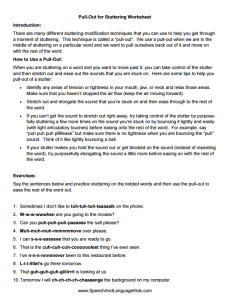Practicing Pull-Outs Activity

Description: Stuck in the middle of a stutter? Try a pull-out! Teach the child the steps to a pull-out first:
- Identify any areas of tension or tightness in your mouth, jaw, or neck and relax those areas. Make sure that you haven’t stopped the air flow (keep the air moving forward).
- Stretch out and elongate the sound that you’re stuck on and then ease through to the rest of the word.
- If you can’t get the sound to stretch out right away, try taking control of the stutter by purposefully stuttering a few more times on the sound you’re stuck on by bouncing it lightly and easily (with light articulatory touches) before easing onto the rest of the word. For example, say “puh puh puh plllllease” but make sure there is no tightness when you are bouncing the “puh” sound. Think of it like lightly bouncing a ball.
- If your stutter makes you hold the sound out or get blocked on the sound (instead of repeating the word), try purposefully elongating the sound a little more before easing on with the rest of the word.
Next, have the child practice the pull-out in sentences that show her exactly what to say, such as the ones on our worksheet above. These should include a pseudo stutter along with the elongated version of the word right after. Have the child practice these pseudo stutters and pull-outs and then use that in conversation as well. Eventually, have the child work up to using this strategy in real stutters.
Click Here to Join the Membership and Download this Activity Right Now!

